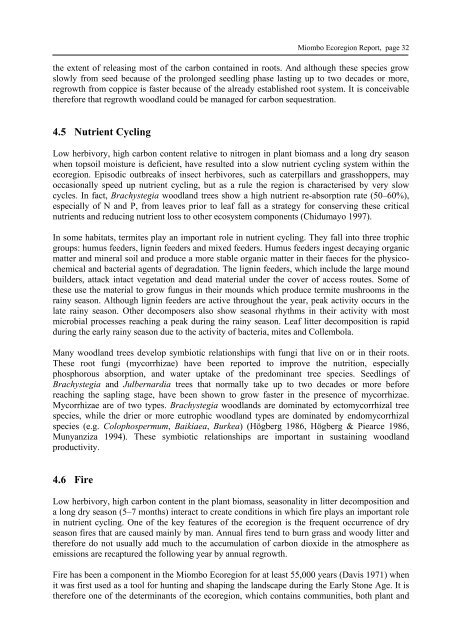Miombo Ecoregion Vision Report - Biodiversity Foundation for Africa
Miombo Ecoregion Vision Report - Biodiversity Foundation for Africa
Miombo Ecoregion Vision Report - Biodiversity Foundation for Africa
Create successful ePaper yourself
Turn your PDF publications into a flip-book with our unique Google optimized e-Paper software.
<strong>Miombo</strong> <strong>Ecoregion</strong> <strong>Report</strong>, page 32<br />
the extent of releasing most of the carbon contained in roots. And although these species grow<br />
slowly from seed because of the prolonged seedling phase lasting up to two decades or more,<br />
regrowth from coppice is faster because of the already established root system. It is conceivable<br />
there<strong>for</strong>e that regrowth woodland could be managed <strong>for</strong> carbon sequestration.<br />
4.5 Nutrient Cycling<br />
Low herbivory, high carbon content relative to nitrogen in plant biomass and a long dry season<br />
when topsoil moisture is deficient, have resulted into a slow nutrient cycling system within the<br />
ecoregion. Episodic outbreaks of insect herbivores, such as caterpillars and grasshoppers, may<br />
occasionally speed up nutrient cycling, but as a rule the region is characterised by very slow<br />
cycles. In fact, Brachystegia woodland trees show a high nutrient re-absorption rate (50–60%),<br />
especially of N and P, from leaves prior to leaf fall as a strategy <strong>for</strong> conserving these critical<br />
nutrients and reducing nutrient loss to other ecosystem components (Chidumayo 1997).<br />
In some habitats, termites play an important role in nutrient cycling. They fall into three trophic<br />
groups: humus feeders, lignin feeders and mixed feeders. Humus feeders ingest decaying organic<br />
matter and mineral soil and produce a more stable organic matter in their faeces <strong>for</strong> the physicochemical<br />
and bacterial agents of degradation. The lignin feeders, which include the large mound<br />
builders, attack intact vegetation and dead material under the cover of access routes. Some of<br />
these use the material to grow fungus in their mounds which produce termite mushrooms in the<br />
rainy season. Although lignin feeders are active throughout the year, peak activity occurs in the<br />
late rainy season. Other decomposers also show seasonal rhythms in their activity with most<br />
microbial processes reaching a peak during the rainy season. Leaf litter decomposition is rapid<br />
during the early rainy season due to the activity of bacteria, mites and Collembola.<br />
Many woodland trees develop symbiotic relationships with fungi that live on or in their roots.<br />
These root fungi (mycorrhizae) have been reported to improve the nutrition, especially<br />
phosphorous absorption, and water uptake of the predominant tree species. Seedlings of<br />
Brachystegia and Julbernardia trees that normally take up to two decades or more be<strong>for</strong>e<br />
reaching the sapling stage, have been shown to grow faster in the presence of mycorrhizae.<br />
Mycorrhizae are of two types. Brachystegia woodlands are dominated by ectomycorrhizal tree<br />
species, while the drier or more eutrophic woodland types are dominated by endomycorrhizal<br />
species (e.g. Colophospermum, Baikiaea, Burkea) (Högberg 1986, Högberg & Piearce 1986,<br />
Munyanziza 1994). These symbiotic relationships are important in sustaining woodland<br />
productivity.<br />
4.6 Fire<br />
Low herbivory, high carbon content in the plant biomass, seasonality in litter decomposition and<br />
a long dry season (5–7 months) interact to create conditions in which fire plays an important role<br />
in nutrient cycling. One of the key features of the ecoregion is the frequent occurrence of dry<br />
season fires that are caused mainly by man. Annual fires tend to burn grass and woody litter and<br />
there<strong>for</strong>e do not usually add much to the accumulation of carbon dioxide in the atmosphere as<br />
emissions are recaptured the following year by annual regrowth.<br />
Fire has been a component in the <strong>Miombo</strong> <strong>Ecoregion</strong> <strong>for</strong> at least 55,000 years (Davis 1971) when<br />
it was first used as a tool <strong>for</strong> hunting and shaping the landscape during the Early Stone Age. It is<br />
there<strong>for</strong>e one of the determinants of the ecoregion, which contains communities, both plant and


